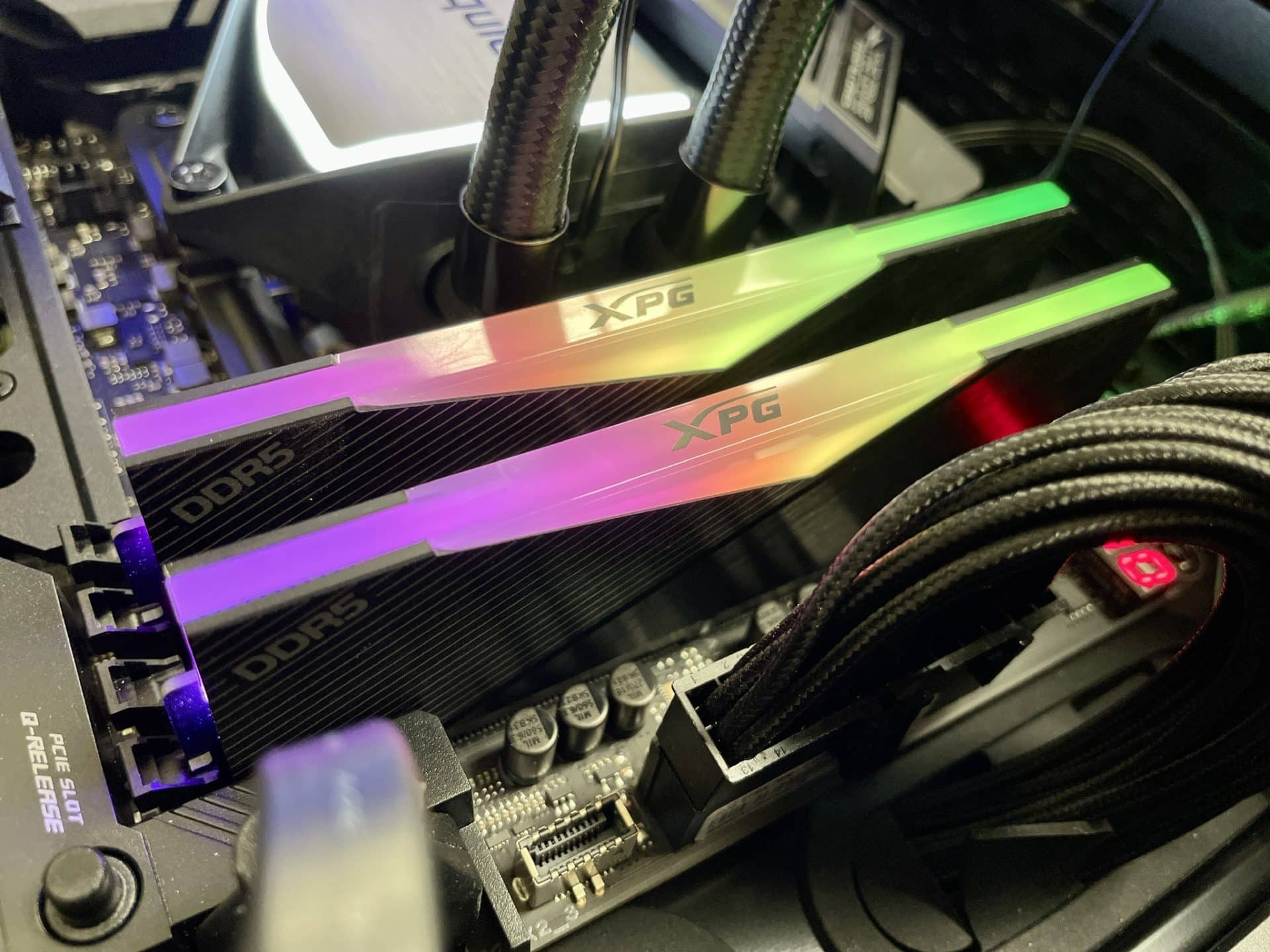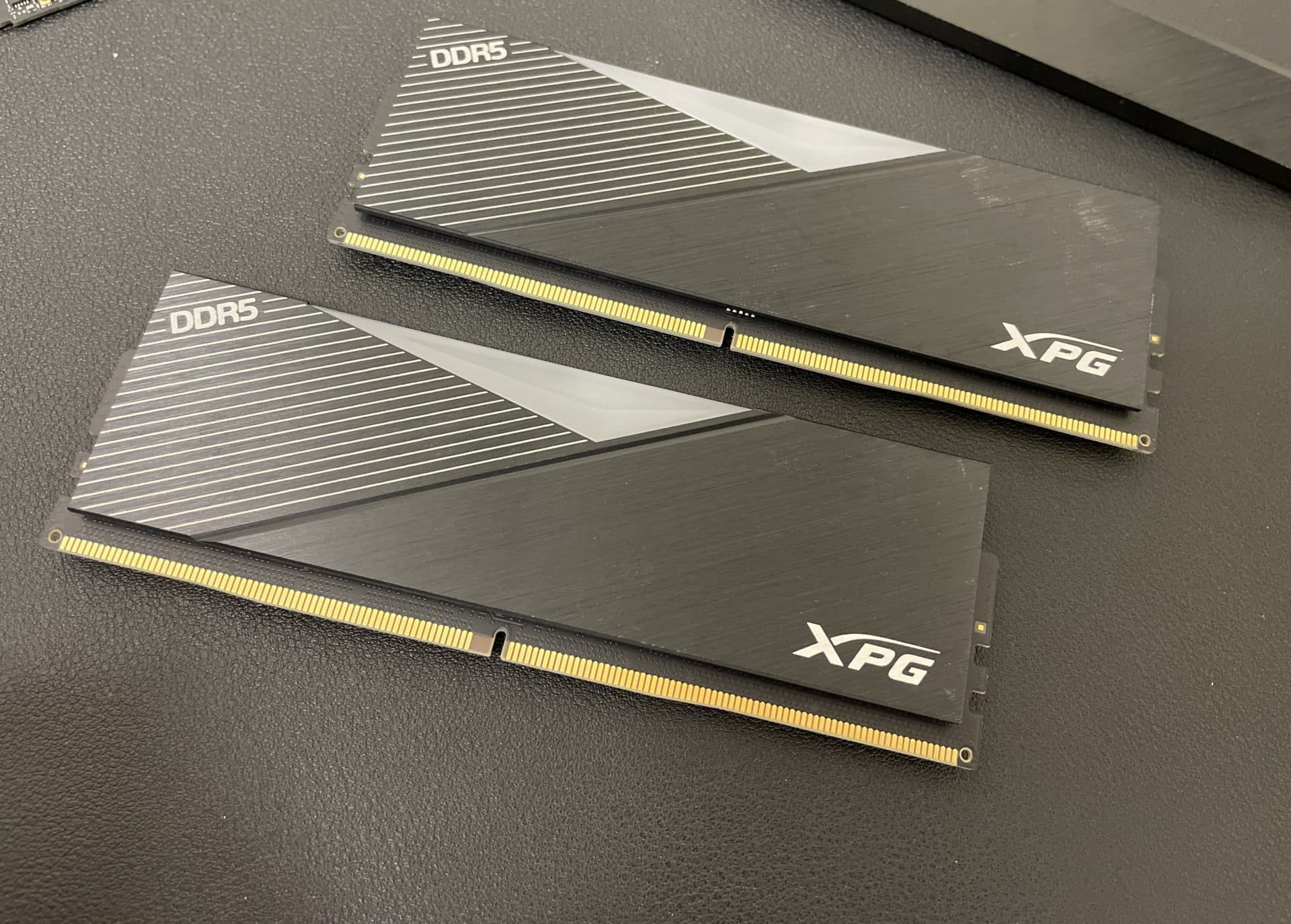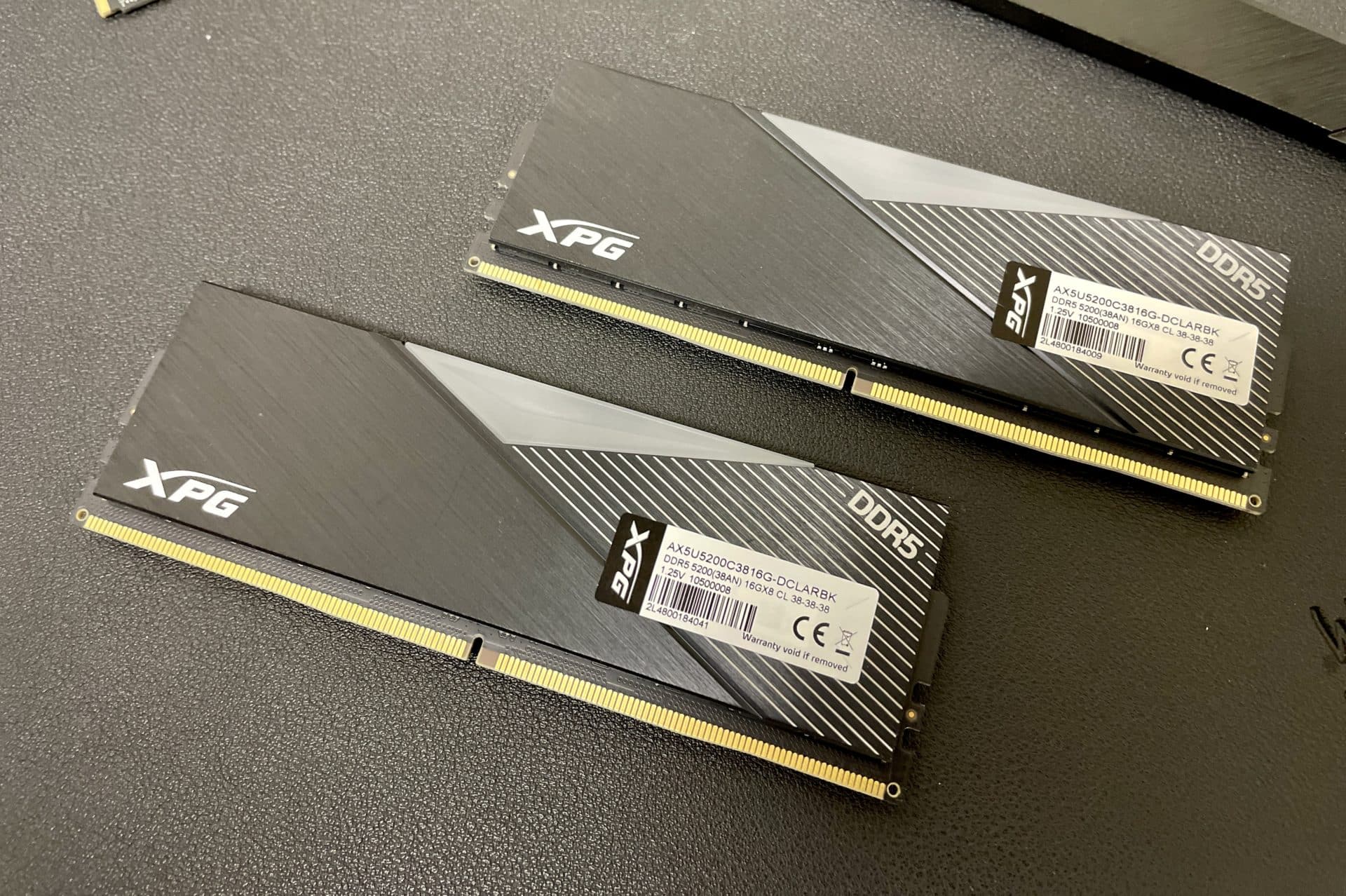We continue our DDR5 memory reviews with XPG Lancer RGB DDR5, a high-performance kit from ADATA. It runs slightly faster than the DDR5-4800 standard, at DDR5-5200, and advertises tighter timings than most kits we’ve seen. Its RGB lighting effects aren’t to be missed, either.

XPG Lancer RGB DDR5-5200 Specifications
DDR5 is the new memory standard for mainstream PCs as of late 2021, offering higher memory bandwidth and potentially lower power consumption than DDR4. It’s not going to replace DDR4 right away and is currently used in only high-end platforms due to its comparatively high cost.
The 32GB kit (2x 16GB) of XPG Lancer RGB DDR5-5200 memory under review here retails for $299 on Amazon, slightly more than the Kingston Fury Beast DDR5-5200 memory we already reviewed (which is currently $273). If that sounds like a lot of money for 32GB of memory, it is; 32GB of DDR4-3200 can be had for $100 to $120. It will be several years before DDR5 achieves price parity with DDR4. It’s the price you’ll pay for being an early adopter.
XPG Lancer RGB DDR5-5200 is high-performance memory since it runs at a higher frequency than the DDR5-4800 standard. Its price reflects that; a 32GB DDR5-4800 kit from XPG’s parent company, ADATA, goes for about $260 on Amazon.

The XPG kit backs up its performance aspirations with attractive aluminum heat spreaders. We’re testing the black version, but they also come in white. Its built-in RGB lights are an easy way to show this memory in a windowed case. The lights can be controlled using the apps that come with most motherboards.
Installing XPG Lancer RGB DDR5 is just as easy as DDR4. Both DDR4 and DDR5 use 288-pin DIMMs, though a different notch position makes it impossible to install DDR5 memory in a DDR4 slot and vice versa.

The full specifications of the XPG Lancer RGB DDR5-5200 memory are as follows. (Also see this memory on XPG’s website.)
| Memory Type/Form Factor | DDR5 U-DIMM |
| Colors | Black/White |
| Capacity | 16GB |
| Speeds | 5200, 6000MT/s |
| CAS Latencies | 38, 48 |
| Operating Voltage | 1.25V, 1.35V |
| Operating Temperature | 0 to 85 degrees C |
| Dimensions | 133.35 by 40 by 8 mm |
| Weight | 74g |
| Warranty | Lifetime limited warranty |
XPG Lancer RGB DDR5-5200 Performance
We use our self-built StorageReview desktop to test DDR5 memory. It has the following specifications:
- Intel Core i9-12900K CPU (slightly undervolted)
- Asus ROG Strix Z690-E Gaming WiFi motherboard
- Microsoft Windows 11
- Seagate FireCuda 530 2TB SSD
The XPG Lancer RGB DDR5-5200 kit reviewed here is two 16GB modules (32GB) total. We benchmarked it at its rated DDR5-5200 speed both with and without its XMP II profile engaged. Its timings are as follows:
- DDR5-5200 CL40-40-40-61 (no XMP)
- DDR5-5200 CL38-38-38-60 (XMP II)
As expected, engaging the XMP II profile tightens up the timings versus our motherboard’s default settings. The other kits we are using for comparison include:
- 32GB (2x 16GB) Kingston Fury Beast DDR5-5200
- DDR5-4800 CL40-39-39-58 (no XMP)
- DDR5-4800 CL38-38-38-57 (XMP II)
- DDR5-5200 CL40-39-39-61 (no XMP)
- DDR5-5200 CL40-40-40-61 (XMP II)
- 64GB (2x 32GB) Corsair Vengeance DDR5-4400
- DDR5-4000 CL32-32-32-54 (no XMP; would not run at rated DDR5-4400 without XMP)
- DDR5-4400 CL36-36-36-59 (XMP II)
- 32GB (2x 16GB) Team Group T-Force Delta RGB DDR5-5200
- DDR5-5200 CL40-40-40-61 (no XMP)
- DDR5-5200 CL40-40-40-61 (XMP II)
Comparisons will be somewhat inexact because the kits aren’t all the same capacity or speed. That said, it will still be possible to infer whether the XPG kit’s high frequency and relatively low latency separate it from the others.
SiSoftware Sandra 2021
We start with the popular SiSoftware Sandra 2021 suite. Higher numbers are better in all subtests. The DDR5-5200 tests are first, both with and without XMP II profiles engaged. We are leaving the Corsair kit out of this since it can’t run at DDR5-5200.
| XPG Lancer RGB DDR5-5200 | Team Group T-Force Delta RGB DDR5-5200 | Kingston Fury Beast DDR5-5200 | ||||
| No XMP | XMP II | No XMP | XMP II | No XMP | XMP II | |
| Memory Bandwidth | 62.560GB/s | 62.945GB/s | 62.352GB/s | 62.243GB/s | 62.758GB/s | 61.811GB/s |
| Cache & Memory Latency | 32.9ns | 34.0ns | 32.9ns | 33.4ns | 32.9ns | 33.4ns |
| Cache & Memory Bandwidth | 485.656GB/s | 487.290GB/s | 487.508GB/s | 487.176GB/s | 493.096GB/s | 484.779GB/s |
| Overall Memory Score | 2.46kPT | 2.44kPT | 2.44kPT | 2.46kPT | 2.48kPT | 2.44kPT |
The XPG’s memory bandwidth numbers are slightly better, especially with XMP II engaged; its best showing was 62.945GB/s. Overall, though, calling the XPG kit definitively faster than the others would be too much of a stretch.
Now we’ll see how the XPG DDR5-5200 kit compares to the Kingston kit downclocked to DDR5-4800 and the Corsair Vengeance kit at DDR5-4000 (our motherboard’s default setting) and DDR5-4400 (XMP II).
| XPG Lancer RGB DDR5-5200 | Kingston Fury Beast DDR5-4800 | Corsair Vengeance DDR5 | ||||
| No XMP | XMP II | No XMP | XMP II | No XMP (DDR5-4000) | XMP II (DDR5-4400) | |
| Memory Bandwidth | 62.560GB/s | 62.945GB/s | 54.418GB/s | 58.801GB/s | 52.654GB/s | 54.403GB/s |
| Cache & Memory Latency | 32.9ns | 34.0ns | 34.6ns | 34.5ns | 35.9ns | 35.3ns |
| Cache & Memory Bandwidth | 485.656GB/s | 487.290GB/s | 479.352GB/s | 479.322GB/s | 465.443GB/s | 471.794GB/s |
| Overall Memory Score | 2.46kPT | 2.44kPT | 2.35kPT | 2.36kPT | 2.23kPT | 2.27kPT |
Immediately, we see the XPG kit offers significantly higher memory bandwidth thanks to its higher frequency; with XMP II, it achieved 62.945GB/s versus the 58.801GB/s for the Kingston kit and 54.403GB/s for the Corsair kit (which was running at DDR5-4400). The higher frequency also allowed the XPG kit to enjoy the lowest latency.
7-Zip Compression Benchmark
The excellent 7-Zip file archive tool has a handy built-in compression benchmark. We ran 10 passes using a 128MB dictionary size and all 24 CPU threads of our Core i9-12900K; higher numbers are better.
| XPG Lancer RGB DDR5-5200 | Team Group T-Force Delta RGB DDR5-5200 | Kingston Fury Beast DDR5-5200 | ||||
| No XMP | XMP II | No XMP | XMP II | No XMP | XMP II | |
| Compressing | ||||||
| Current CPU Usage | 2020% | 2012% | 2021% | 2040% | 2022% | 2014% |
| Current Rating/Usage | 4.914 GIPS | 4.952 GIPS | 4.878 GIPS | 4.810 GIPS | 4.846 GIPS | 4.898 GIPS |
| Current Rating | 99.263 GIPS | 99.645 GIPS | 98.558 GIPS | 98.109 GIPS | 97.977 GIPS | 98.664 GIPS |
| Resulting CPU Usage | 2021% | 2022% | 2025% | 2023% | 2024% | 2017% |
| Resulting Rating/Usage | 4.875 GIPS | 4.908 GIPS | 4.858 GIPS | 4.850 GIPS | 4.847 GIPS | 4.855 GIPS |
| Resulting Rating | 98.499 GIPS | 99.257 GIPS | 98.369 GIPS | 98.142 GIPS | 98.098 GIPS | 97.934 GIPS |
| Decompressing | ||||||
| Current CPU Usage | 2300% | 2298% | 2314% | 2325% | 2264% | 2306% |
| Current Rating/Usage | 5.856 GIPS | 5.822 GIPS | 5.839 GIPS | 5.703 GIPS | 5.764 GIPS | 5.661 GIPS |
| Current Rating | 134.663 GIPS | 133.801 GIPS | 135.102 GIPS | 132.588 GIPS | 130.510 GIPS | 130.539 GIPS |
| Resulting CPU Usage | 2300% | 2292% | 2304% | 2300% | 2276% | 2298% |
| Resulting Rating/Usage | 5.811 GIPS | 5.774 GIPS | 5.806 GIPS | 5.776 GIPS | 5.781 GIPS | 5.737 GIPS |
| Resulting Rating | 133.669 GIPS | 132.347 GIPS | 133.791 GIPS | 132.838 GIPS | 131.604 GIPS | 131.818 GIPS |
| Total Ratings | ||||||
| Total CPU Usage | 2160% | 2157% | 2165% | 2162% | 2150% | 2157% |
| Total Rating/Usage | 5.343 GIPS | 5.341 GIPS | 5.332 GIPS | 5.313 GIPS | 5.314 GIPS | 5.296 GIPS |
| Total Rating | 116.084 GIPS | 115.082 GIPS | 116.080 GIPS | 115.490 GIPS | 114.851 GIPS | 114.876 GIPS |
As we’ve come to expect in this benchmark, the total ratings tend to smooth out the differences between kits. The compression sub-scores show the significant differences, where the XPG kit shined. In XMP II, its resulting rating was 99.257 GIPS compared to the Team Group’s 98.142 GIPS and the Kingston’s 97.934 GIPS.
Now for how the XPG DDR5-5200 kit performs against the Kingston kit downclocked to DDR5-4800 and the Corsair Vengeance.
| XPG Lancer RGB DDR5-5200 | Kingston Fury Beast DDR5-4800 | Corsair Vengeance DDR5 | ||||
| No XMP | XMP II | No XMP | XMP II | No XMP (DDR5-4000) | XMP II (DDR5-4400) | |
| Compressing | ||||||
| Current CPU Usage | 2020% | 2012% | 2035% | 2016% | 2001% | 1996% |
| Current Rating/Usage | 4.914 GIPS | 4.952 GIPS | 4.565 GIPS | 4.595 GIPS | 4.478 GIPS | 4.583 GIPS |
| Current Rating | 99.263 GIPS | 99.645 GIPS | 92.913 GIPS | 92.664 GIPS | 89.612 GIPS | 91.460 GIPS |
| Resulting CPU Usage | 2021% | 2022% | 2032% | 2017% | 1999% | 2004% |
| Resulting Rating/Usage | 4.875 GIPS | 4.908 GIPS | 4.601 GIPS | 4.656 GIPS | 4.401 GIPS | 4.537 GIPS |
| Resulting Rating | 98.499 GIPS | 99.257 GIPS | 93.468 GIPS | 93.905 GIPS | 87.978 GIPS | 90.932 GIPS |
| Decompressing | ||||||
| Current CPU Usage | 2300% | 2298% | 2278% | 2319% | 2307% | 2296% |
| Current Rating/Usage | 5.856 GIPS | 5.822 GIPS | 5.766 GIPS | 5.700 GIPS | 5.681 GIPS | 5.702 GIPS |
| Current Rating | 134.663 GIPS | 133.801 GIPS | 131.324 GIPS | 132.166 GIPS | 131.065 GIPS | 130.922 GIPS |
| Resulting CPU Usage | 2300% | 2292% | 2247% | 2312% | 2284% | 2291% |
| Resulting Rating/Usage | 5.811 GIPS | 5.774 GIPS | 5.744 GIPS | 5.721 GIPS | 5.701 GIPS | 5.722 GIPS |
| Resulting Rating | 133.669 GIPS | 132.347 GIPS | 129.050 GIPS | 132.262 GIPS | 130.237 GIPS | 131.083 GIPS |
| Total Ratings | ||||||
| Total CPU Usage | 2160% | 2157% | 2139% | 2164% | 2142% | 2147% |
| Total Rating/Usage | 5.343 GIPS | 5.341 GIPS | 5.172 GIPS | 5.188 GIPS | 5.051 GIPS | 5.130 GIPS |
| Total Rating | 116.084 GIPS | 115.082 GIPS | 111.259 GIPS | 113.083 GIPS | 109.108 GIPS | 111.008 GIPS |
Focusing on the compression scores, the XPG kit expectedly scored better across the board, thanks to its higher frequency. With XMP II engaged, its resulting rating of 99.257 GIPS far outpaced the Kingston’s 93.905 GIPS and the Corsair’s 90.932 GIPS.
Conclusion
XPG Lancer RGB DDR5 is the fastest DDR5-5200 kit we’ve tested to date. Its aggressive timings helped it achieve best-in-class benchmark scores next to kits from Kingston and Team Group. The differences weren’t massive and likely won’t be noticeable day to day, so we wouldn’t recommend spending significantly more for this kit for that reason, but it’s the sensible pick if the prices are close.
We also demonstrated that the XPG kit at DDR5-5200 has noticeable bandwidth and latency advantages over DDR5-4800, DDR5-4400, and DDR5-4000. Those investing in Intel Core i9 or AMD Ryzen 9 systems will be able to squeeze more performance out of them with faster memory.
We also like the XPG Lancer RGB DDR5’s aluminum heat spreaders, which aren’t always included on DDR5 modules, and its RGB lighting and lifetime warranty. Overall, the kit comes highly recommended.




 Amazon
Amazon